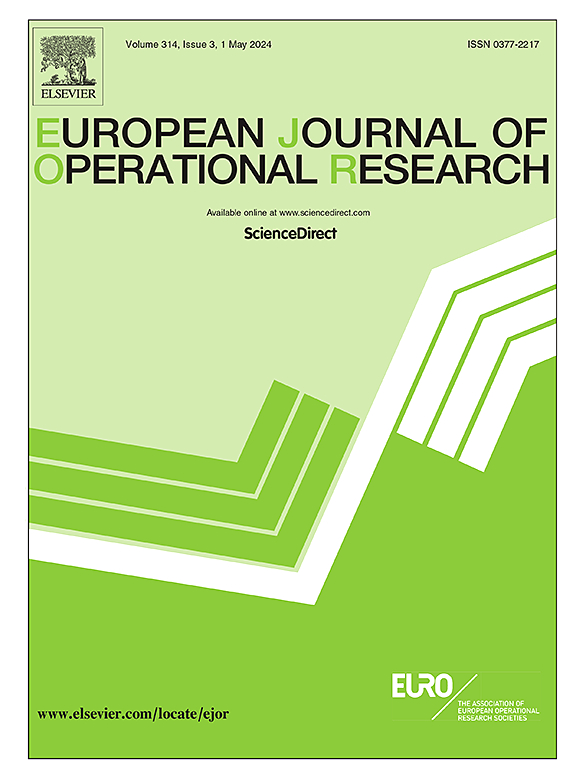优化综合泊位分配和码头起重机分配:分布稳健法
IF 6
2区 管理学
Q1 OPERATIONS RESEARCH & MANAGEMENT SCIENCE
引用次数: 0
摘要
在这项研究中,我们在均值-方差模糊集的背景下建立了一个两阶段分布式稳健优化(TDRO)模型,专门用于应对综合泊位分配和码头起重机分配问题(BACAP)中的挑战。本研究的一个主要考虑因素是与船舶抵达时间相关的内在不确定性。在初始阶段,我们得出了泊位分配和码头起重机分配的基线时间表。考虑到不确定的抵达延迟可能造成的干扰,我们在第二阶段进行了精心设计,以确定均值-方差模糊集内调整成本的最坏情况预期。随后,我们进行了等效转换,将一般 TDRO 模型转换为两阶段稳健二阶锥形编程(TRO-SOCP)模型。这种转换方便了列和约束生成(C&CG)算法的应用,确保了精确解的推导。为了解决与二阶圆锥编程相关的复杂计算问题,我们提出了两种上下限增强策略,旨在加快求解过程。此外,为了应对大规模实例,我们引入了一种细化和近似方法,将 TDRO 模型转化为混合整数编程(MIP)模型。此外,我们还在合成实例和真实实例上进行了大量数值实验,以验证我们的模型和算法的卓越性能。在总成本方面,TDRO 模型与两阶段随机程序设计 (TSP) 模型和两阶段鲁棒性优化 (TRO) 模型相比表现出更优越的性能。本文章由计算机程序翻译,如有差异,请以英文原文为准。
Optimizing integrated berth allocation and quay crane assignment: A distributionally robust approach
In this research, we have formulated a Two-Stage Distributionally Robust Optimization (TDRO) model within the context of a mean–variance ambiguity set, specifically designed to address the challenges in the Integrated Berth Allocation and Quay Crane Assignment Problem (BACAP). A key consideration in this study is the inherent uncertainty associated with ships’ arrival times. During the initial stage, we derive a baseline schedule governing berth allocation and quay crane assignment. Anticipating potential disruptions arising from uncertain arrival delays, the second stage is meticulously formulated to determine the worst-case expectation of adjustment costs within the mean–variance ambiguity set. Subsequently, we undertake an equivalent transformation, converting the general TDRO model into a Two-Stage Robust Second-Order Cone Programming (TRO-SOCP) model. This transformation facilitates the application of the Column and Constraint Generation (C&CG) algorithm, ensuring the derivation of an exact solution. To address the computational intricacies associated with second-order cone programming, we propose two enhancement strategies for upper and lower bounds, aimed at expediting the solution process. Additionally, to contend with large-scale instances, we introduce a refinement and approximation method, transforming the TDRO model into a Mixed-Integer Programming (MIP) model. Furthermore, extensive numerical experiments are executed on both synthetic and real-life instances to validate the superior performance of our model and algorithms. In terms of the total cost, the TDRO model demonstrates superior performance compared with Two-Stage Stochastic Programming (TSP) and Two-Stage Robust Optimization (TRO) models.
求助全文
通过发布文献求助,成功后即可免费获取论文全文。
去求助
来源期刊

European Journal of Operational Research
管理科学-运筹学与管理科学
CiteScore
11.90
自引率
9.40%
发文量
786
审稿时长
8.2 months
期刊介绍:
The European Journal of Operational Research (EJOR) publishes high quality, original papers that contribute to the methodology of operational research (OR) and to the practice of decision making.
 求助内容:
求助内容: 应助结果提醒方式:
应助结果提醒方式:


